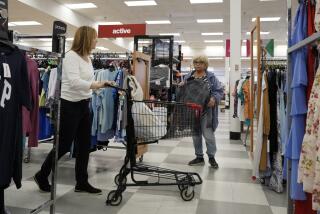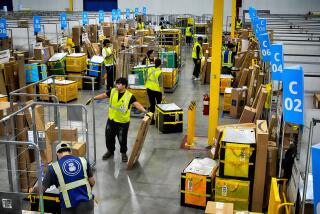Mexico Says Economy Grew 8.8% in Quarter
- Share via
MEXICO CITY — Mexican consumers are finally returning to the nation’s department stores and auto showrooms, helping to boost economic growth measured by the government Monday at an unexpectedly high 8.8% in the second quarter--the biggest quarterly leap in 15 years.
Until recently, Mexican consumers have by and large stayed on the sidelines as the country’s economy righted itself. Their purchasing power was devastated by the peso devaluation of late 1994, the ensuing loss of millions of jobs and the exorbitant cost of consumer loans.
The main driver of Mexico’s recovery is still industry, which has produced 12% more goods over the first half of this year than during the first six months of last year, according to Salomon Bros. of New York. Most of those goods are bound for foreign markets, especially the United States.
But the awakening of the consumer economy is politically important for President Ernesto Zedillo and bodes well for the United States in numerous ways, increasing the market for U.S. goods here and generating jobs for Mexicans who might otherwise illegally enter the United States.
Indeed, Mexico is projected to add 1 million new jobs this year--just enough to keep even with the birthrate. The country lost 1 million jobs in 1995 at the trough of the recession.
“We’re seeing evidence that the 90-million-person Mexican consumer market is finally coming back to life,” said Lawrence Goodman, an economist with Salomon Bros., who said his firm had projected second-quarter growth of only 6.5%.
Although year-to-date retail data weren’t available, retail sales have been increasing. Figures released last month by government statisticians showed a 6.5% increase in retail sales in May over the same month in 1996.
Through June, for example, Mexicans bought 197,039 cars, trucks and vans, a 43% increase over the unit sales during the same period last year, according to the Mexican Assn. of Automobile Distributors. That’s still a third less than were sold in the first half of 1994, before the crisis hit, but a positive sign nonetheless.
Sears and Home Mart, U.S. retail chains with strong presences in Mexico, also report a recent burst in consumer activity. Home Mart demonstrated its confidence by opening a seventh store in the Mexico City area this summer. Executives said buyer activity has been especially strong in the past two months.
Goodman said there is blossoming, broad-based demand for consumer goods, from big-ticket appliances to restaurant meals and routine retail expenditures. Goodman’s main source of worry: a strengthening peso and the possibility it could reignite Mexicans’ passion for imported goods, an appetite that got out of control prior to the 1994 crisis and helped trigger the peso’s collapse.
Goodman also noted that much of the recent industrial activity has gone simply to replace inventories that retailers hadn’t bothered to restock until now. The recovery’s proof lies in whether consumers actually buy those goods in coming months, he added.
“The growth is larger than we thought, more rapid than was foreseen,” said a researcher at the Center for Economic Studies for the Private Sector, a Mexico City think tank.
For the first half of 1997, Mexican economic growth in real, inflation-adjusted terms was 7%, according to the secretary of the treasury.
*
In addition to industrial activity, the government said economic growth was helped along by a resurgence in agriculture, with increased harvests of wheat, corn, citrus fruits and beans. Services, including tourism and transportation, are also up strongly, by 6.3% over the first half of the year compared with the same period last year.
Inflation also has been tamed, if not vanquished, with prognosticators foreseeing a 17% rise in 1997--down from 27% in 1996 and the horrendous 52% in 1995 in the aftermath of the peso crisis.
More to Read
Sign up for Essential California
The most important California stories and recommendations in your inbox every morning.
You may occasionally receive promotional content from the Los Angeles Times.










